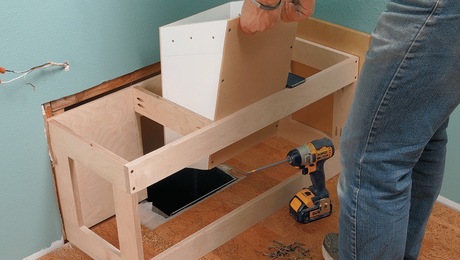Want to reduce noise from 1st floor into 2nd floor bedroom
20 year old house has master bedroom directly over kitchen/dinet. With all drywall and a ceramic tile floor in the kitchen, every noise in the kitchen area seems to get amplified and carries thru the floor up into the master bedroom. Looking for ideas to reduce the noise coupled upstairs. There are no plumbing runs, and only 2 heat ducts that run under the bedroom floor– the rest are hollow, with a few light fixtures. The joist bays can be accessed by cutting holes in the bedroom floor (pull back the carpet)
Some ideas:
1. Fill or partially fill the joist bays with cellulose insulation (need to replace some can lights with insulation contact rated fixtures). Is this OK to insulate between floors?
2, Same question but what about self expanding foam (open cell or closed cell?). Only small holes needed to provide access to inject hte foam.
3. Is there any type of carpet padding that reduces noise thru the floor (easy to replace carpet padding).
4. Any other ideas to reduce the noise transmission from 1st to 2nd floor?
Thanks


















Replies
rm
There's a couple things that work marginally, but together might help. First, some more specifics.
The ducts-what kind, metal or flex? Supply or air return-main trunks or branches?
Some cans? how many? Soffits at the kitchen ceilings?
Insulating between the floor/ceiling does help somewhat-breaks up the resonating sound which dampens it.
Mass is your friend when trying to block sound transfer-and uncoupling direct connections don't hurt either. So, adding mass to the ceiling in the kitchen or floor above would help-relay the carpet after installing a layer of 1/2" Homasote over the sheeting, for instance.
Cross furring (strapping) the ceiling of the kitchen and hanging some sound reducing drywall or perhaps just using 5/8's. Using resilient channel as the furring could do a little better job...........
What kind of noise is bothersome? pots and pans-dishwasher loading-usual kitchen noise?...........or talking? A little consideration from the rest of the housemates can do alot to help out and it's cheaper.
More details
Some additional details on the kitchen area. There are 2 branch Metal heating ducts that run to center wall then down to basement-- no coupling to kitchen directly. Return air runs through the same center wall
7 cans spread around 14 x 28 foot kitchen/dinet area.
I concur that more mass makes for a quieter home-- our previous house was plaster construction instead of Drywall-- MUCH quieter. On that house, I did see a marked reduction in street noise when we insulated the walls with blown in Cellulose so thought about that here.
I could change a significant length of the heating ducts to flex instead of rigid metal without too much trouble. Might help eliminate some echos and carrying noise from other locations.
Seems that any noise comes through-- not specific to high or low frequencies. Even people talking in low voices can be heard.
Thanks
rm
The air return, could be transmitting alot of the bothersome noise.. They used to have simple pipe that ran from the kitchen up to the maids qtrs.............didn't even have to yell. If it's open to the upstairs (a given) then that is a prime source.
Soffits that are not blocked (fire stopped) are another good source of magnified sound-they act like a drum-big expanse capturing the vibrations with a hollow behind it and nothing to block it except your floor.
Insulating the ceiling above is a good measure-but those cans, air returns and soffits need to be considered.
The more ambitious measures of adding mass and divorcing ceiling couplings might benefit alot if the other things are also taken care of.
This will affect heating and cooling, but playing with the return air ducts might be tried as an experiment.
When you can hear voices clearly it usually means that there is some relatively direct connection, perhaps through the ducts, perhaps just cracks at the edges that allow sound through.
The ideal fix is to treat the ceiling below, ideally installing resiliant hangers and then drywall.
Cellulose is moderately effective, foam not so. Foam is too light and stiff to be a good damping material (though judicious use of it to seal cracks may produce some significant benefit).
Do double check that the heating ducts don't "communicate" between the kitchen and upstairs, and even if a duct doesn't run into the bedroom, if it's open to the kitchen it will pick up sound and carry it into the floor.
If all else fails, turn up the radio.
noise
1 loose the can lights - penetrations allow sound to pass thru.
2 do furring 3/4" 90° to the joists, then second ply of SR, or one of the better ceiling boards made specicically for sound
3 spray foam would be a great help. Every homeowner I have used this for re thermal insulation, remarks on how quite their home is as a side effect